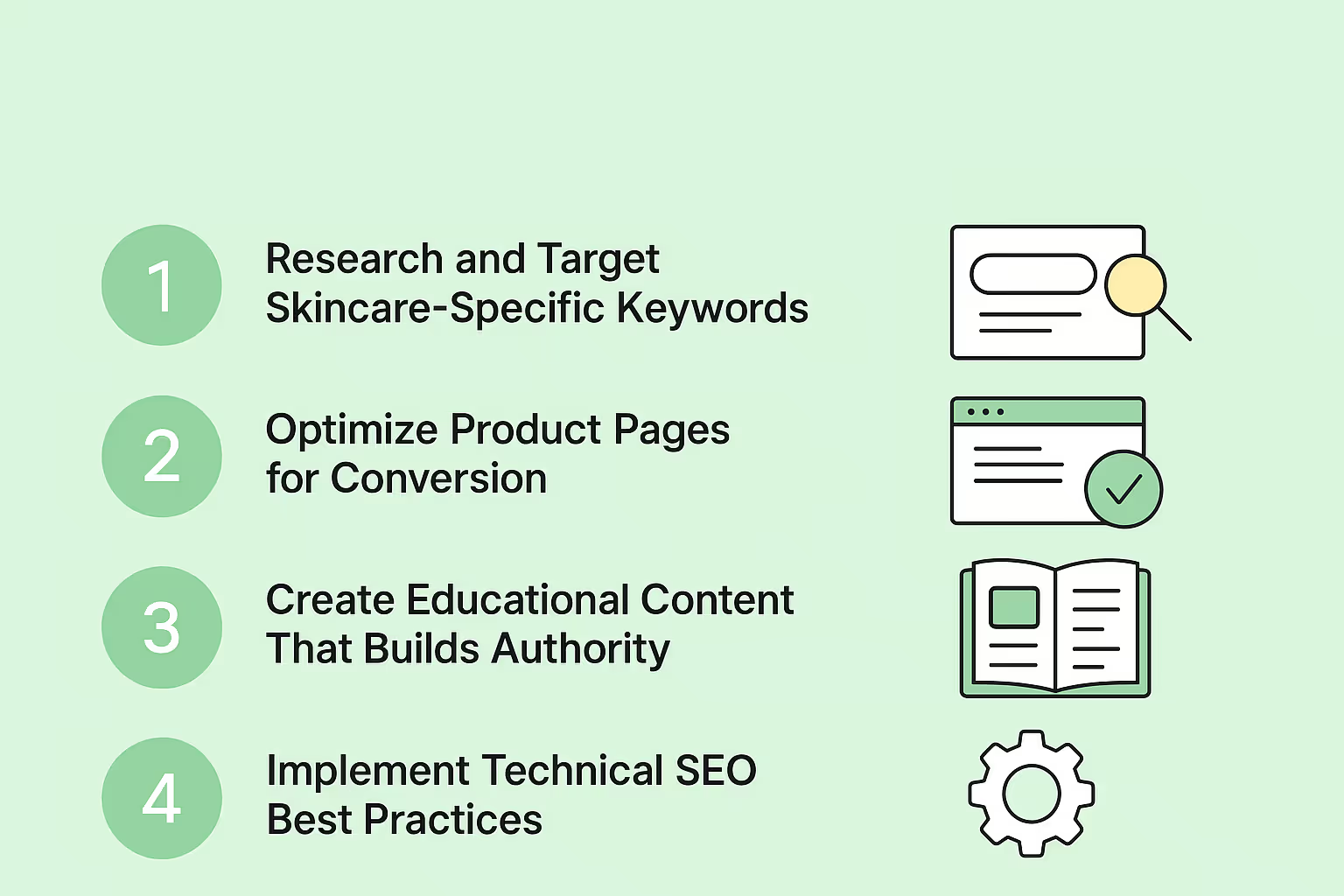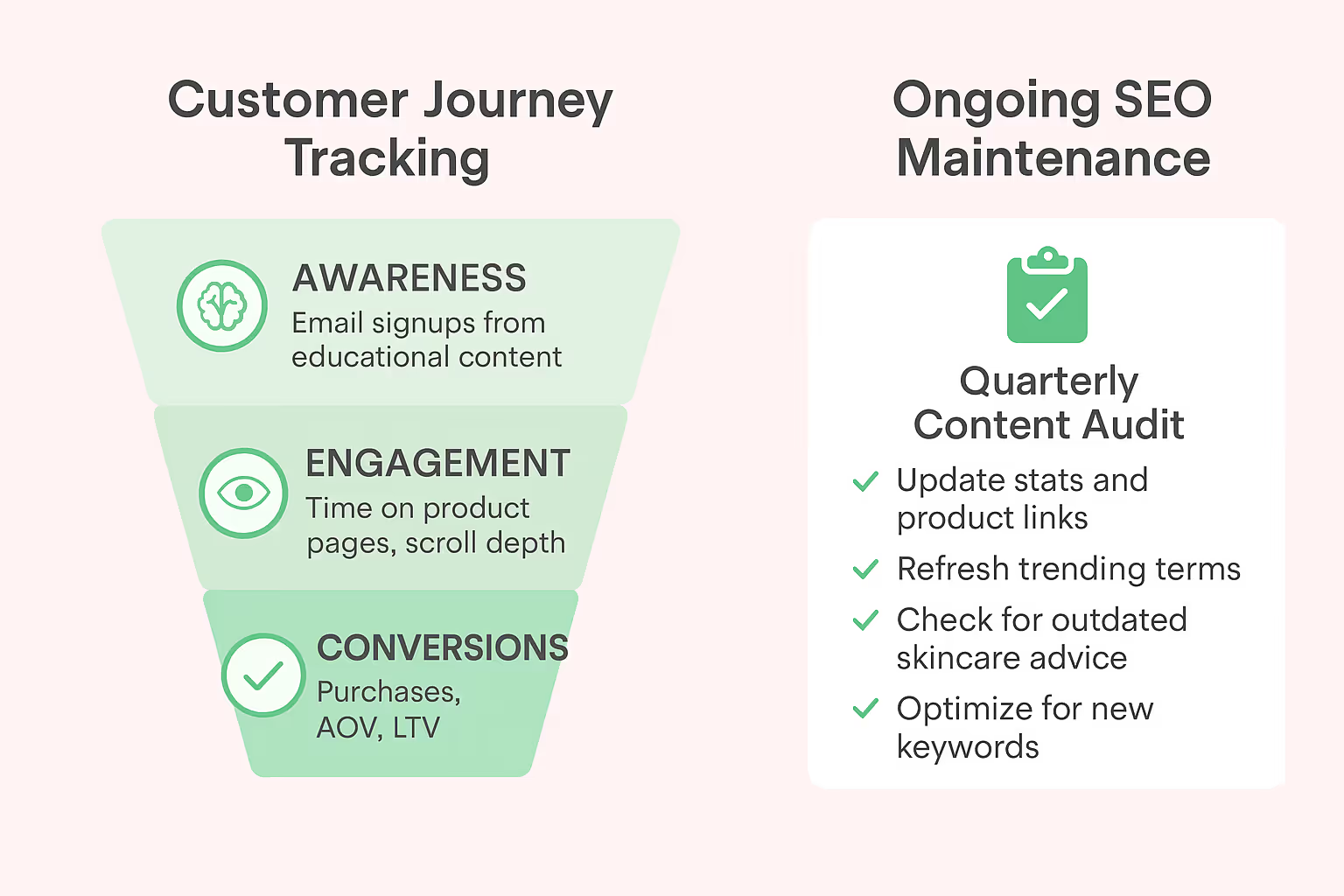
The skincare industry has surged into a $180+ billion global market, with 81% of shoppers conducting online research before buying beauty products.
Whether you're selling anti-aging serums or acne treatments, learning how to use SEO for skin care marketing effectively is crucial to staying visible in search results.
Skincare stands apart from other e-commerce sectors. Shoppers dig into ingredient lists, compare brands across platforms, and rely on expert reviews before purchasing.
These habits create a prime opportunity for brands that understand and implement smart search engine optimization strategies.
Step-by-Step SEO Strategy for Skincare Marketing

Implementing effective SEO for skincare marketing requires a systematic approach that addresses the unique search behaviors of beauty consumers.
Step 1: Research and Target Skincare-Specific Keywords
Skincare SEO success starts with recognizing that potential customers search differently than buyers in other industries.
This specificity creates opportunities through several keyword categories:
- Ingredient-focused searches - "niacinamide benefits," "retinol vs retinoid difference"
- Skin concern queries - "best products for hormonal acne," "anti-aging routine for 30s"
- Product comparisons - "CeraVe vs Cetaphil cleanser," "chemical vs physical sunscreen"
- Routine-based searches - "Korean skincare routine steps," "morning vs evening skincare"
Tools like Ahrefs or SEMrush reveal thousands of these detailed searches with lower competition but higher conversion potential.
The key lies in mapping these searches to your product catalog and content strategy while understanding that most skincare purchases begin with informational queries.
Step 2: Optimize Product Pages for Conversion
Standard e-commerce SEO advice often falls short for skincare products. Generic product descriptions don't address the specific concerns and ingredient curiosity that drive skincare purchases.
Effective skincare product pages require a different approach that combines technical optimization with educational value.
Product descriptions should read like mini-educational articles that cover:
- How key ingredients work and their concentrations
- What skin types benefit most from the formulation
- How to incorporate the product into existing routines
- Expected results timeline and usage frequency
User-generated content becomes particularly powerful in skincare SEO. Encourage detailed reviews that mention specific skin concerns, ingredient experiences, and results.
These authentic testimonials often contain natural keyword variations and build trust signals that search engines reward.
Step 3: Create Educational Content That Builds Authority
Educational content serves as the backbone of successful skincare SEO strategies. However, creating content that ranks requires understanding the difference between what dermatologists know and what consumers search for.
The most successful skincare content answers real questions with practical advice. "How to layer skincare products" performs better than "The science of skincare layering" because it matches user intent more precisely. Focus on actionable guides that help users achieve specific results.
Content opportunities that consistently perform well include:
- Ingredient deep-dives covering benefits, usage, and product recommendations
- Routine guides for different skin types, ages, and concerns
- Seasonal skincare advice addressing climate-related skin changes
- Product comparison articles that help users make informed decisions
For brands venturing into private-label skincare, content creation becomes even more critical as it establishes expertise and builds trust with potential customers who may be unfamiliar with newer brands.
Step 4: Implement Technical SEO Best Practices
Technical optimization ensures that search engines can properly crawl, index, and understand skincare content. Several technical considerations become particularly important for beauty and wellness sites.
Skincare brands often struggle with duplicate content issues when selling similar products across different collections.
Create unique angles for each product page, even if formulations are similar. A "morning vitamin C serum" and "anti-aging vitamin C serum" might contain identical ingredients but serve different user intents.
Schema markup becomes essential for skincare products:
- Product schema for pricing, availability, and specifications
- Review the schema to display star ratings in search results
- FAQ schema for common skincare questions
- Article schema for educational content pieces
Internal linking strategy becomes particularly important for skincare sites with extensive product catalogs. Create topic clusters around skin concerns, ingredients, and routines, linking related products and content pieces strategically.
Always remember - Skincare shoppers don’t just buy. They research, compare, and obsess. This framework helps you map real user intent to the right type of content and product pages, so your SEO doesn’t just rank, it converts.
Content Marketing That Builds Authority
Educational content serves as the backbone of successful skincare SEO strategies, but creating content that ranks requires understanding the difference between what dermatologists know and what consumers search for.
Ingredient-focused content creates particularly strong SEO opportunities. Deep-dive articles about popular ingredients like retinol, niacinamide, or hyaluronic acid can capture significant search volume while establishing expertise. These pieces should cover:
- Scientific benefits explained in accessible language
- Usage instructions, including frequency and timing
- Potential side effects and contraindications
- Product recommendations at different price points
Seasonal content planning becomes crucial in skincare SEO. Winter skin concerns differ dramatically from summer ones, creating predictable content opportunities.
Plan seasonal skincare guides, routine adjustments, and product recommendations to capture these cyclical searches.
Video content increasingly dominates skincare searches, particularly for tutorials and product demonstrations. Optimize video content with detailed descriptions, timestamps, and transcripts to capture both video and traditional search traffic.
Publishing content exclusively on your website limits reach potential, repurpose core content across multiple channels while maintaining your website as the primary hub.
Local SEO for Skincare Businesses
Skincare businesses face unique local SEO challenges because customers typically research extensively online before visiting in person.
Optimize Your Google My Business Profile
Google My Business is essential for local skincare retailers and med spas. Keep your profile active by regularly posting about new products, seasonal treatments, and skincare tips.
Encourage customers to leave detailed reviews mentioning specific treatments or products they’ve tried to boost credibility.
Create Locally Relevant Content
Focus content on regional skincare concerns to attract and engage your local audience. Share climate-specific advice, stories about locally sourced ingredients, and highlight community skin health initiatives. Such content helps improve your local search rankings.
Use Dedicated Landing Pages for Services
If your business offers multiple treatments or product categories, create separate landing pages for each.
For example, a med spa should have distinct pages optimized for local search terms related to chemical peels, facials, and retail products to capture targeted traffic effectively.
Measuring Success and Iterating Strategy

Skincare SEO success requires tracking metrics beyond traditional rankings and traffic. Conversion rates, average order values, and customer lifetime value provide better insights into SEO performance than vanity metrics.
Set up goal tracking for different stages of the customer journey. Track email signups from educational content, product page engagement, and actual purchases to understand how SEO traffic converts throughout the funnel.
Regular content audits ensure that skincare content remains accurate and current. Skincare trends evolve rapidly, and outdated information can harm both user experience and search rankings. Schedule quarterly reviews of high-traffic content to update statistics, product recommendations, and trending topics.
Advanced SEO Tactics for Competitive Advantage
The skincare market's competitiveness demands sophisticated SEO strategies that go beyond basic optimization.
Understanding these advanced tactics can provide significant competitive advantages that separate successful brands from the competition.
Competitor gap analysis reveals untapped keyword opportunities that most brands overlook. Tools like Ahrefs' Content Gap feature show keywords that competitors rank for but your site doesn't target. In skincare, these gaps often represent:
- Specific ingredient combinations like "niacinamide and hyaluronic acid together"
- Niche skin concerns such as "skincare for shift workers" or "pregnancy-safe anti-aging"
- Local skincare needs to address climate-specific concerns
- Emerging trends before they become saturated with content
Pro Tip: Most skincare brands miss a massive SEO opportunity by not optimizing for "versus" keywords. Searches like "retinol vs retinoid," "chemical vs physical sunscreen," or "vitamin C vs niacinamide" have high commercial intent but relatively low competition.
Create comprehensive comparison content that positions your products as solutions within these debates.
Tried-and-True Insight: Tap Reddit and Forums for Skincare SEO Trends
Reddit threads and beauty forums like SkincareAddiction are goldmines for SEO insights. They reveal ultra-specific long-tail keywords before they show up in traditional tools like Ahrefs.
Searches like “slugging safe for fungal acne” or “my skin hates niacinamide” signal real concerns and early demand. These low-competition terms carry high intent and are perfect for fast, effective content wins.
Check these platforms weekly and track recurring ingredient pairings or niche concerns. Use them to build SEO blog posts, targeted FAQs, or dedicated landing pages.
This approach keeps your strategy agile and trend-aware while strengthening topical authority. Google increasingly rewards brands that reflect current conversations and evolving skin care needs.
Next Steps for Optimizing Your Skincare SEO
Effective SEO for skin care marketing requires patience, consistency, and a strong grasp of customer behavior. The best results come from systematic implementation, not one-off efforts.
Start with targeted keyword research around specific skin concerns and ingredients. Build a content calendar that covers these topics while optimizing product pages for long-tail commercial terms.
The skincare industry favors brands that educate and empower customers. Prioritize accurate, helpful content that meets user intent, and organic search growth will follow.
FAQ
Related blogs

High-Low Method Calculator: Discover Your True Fixed and Variable Costs

Influencer Pricing Calculator: Find Your Fair Rate for Posts, Reels & Stories
.avif)


.avif)